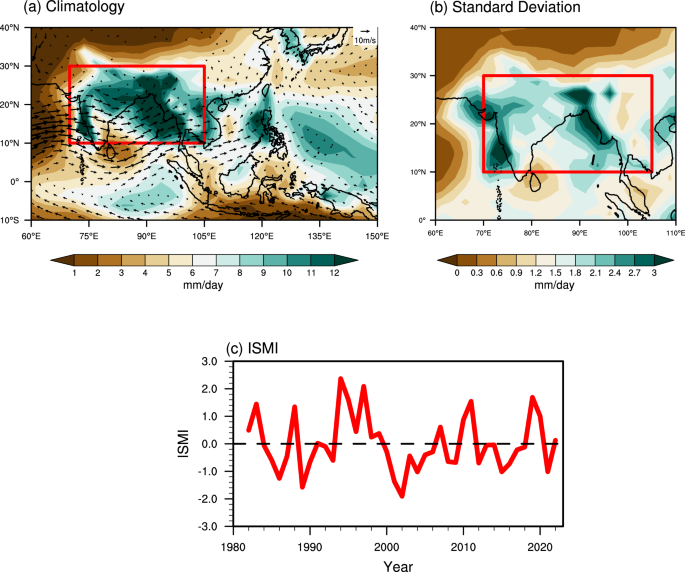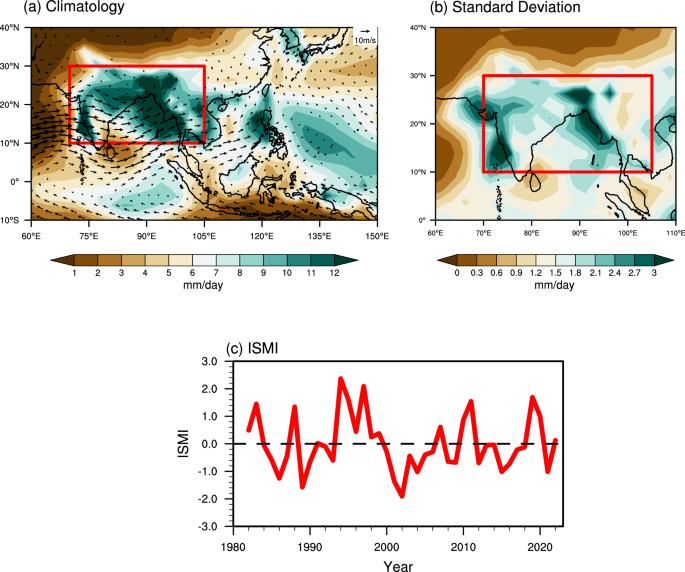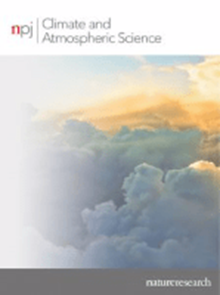印度夏季季风对北极海冰变化的影响
IF 8.5
1区 地球科学
Q1 METEOROLOGY & ATMOSPHERIC SCIENCES
引用次数: 0
摘要
北极海冰消失对北半球夏季天气的影响引起了广泛关注。尽管这种关系受到广泛关注,但热带系统对北极地区的影响却相对探索不足,现有研究中只有有限的几项完全集中于动态或热力学效应。本研究旨在通过研究北极地区与印度夏季季风降雨相关的气压各向异性异常环流来弥补这一空白。观测到的异常环流表现出明显的带偶极模式,其特点是加拿大北部和亚洲上空的异常高压与格陵兰岛以东的异常低压相耦合。通过模式实验验证表明,ISM降雨的二重加热促成了观测到的ISM相关环流的形成。北极上空的环流异常对地表晴空下沉长波辐射(\({{DLR}}_{clear\; sky}})的调节改变了地表热状况,从而影响了海冰厚度和浓度的后续变化。在异常高压下,\({{DLR}}_{clear\; sky}}\)增加,导致海冰厚度下降,反之亦然。此外,从动态角度来看,低空风驱动的海冰漂移有助于形成海冰覆盖的空间分布和范围。此外,ISM 对北极海冰的影响在很大程度上与当代厄尔尼诺/南方涛动无关。这些发现为极地外现象(如 ISM)在夏季驱动北极海冰变化中的作用提供了新的视角。这种进一步的理解有望加强对夏季北极海冰范围变化的预测。本文章由计算机程序翻译,如有差异,请以英文原文为准。


Indian summer monsoon’s role in shaping variability in Arctic sea ice
The impacts of Arctic sea ice loss on summertime weather in the Northern Hemisphere have garnered considerable attention. Despite the extensive focus on this relationship, the influence of tropical systems on Arctic regions has been relatively underexplored, with only a limited number of existing studies concentrating exclusively on either dynamic or thermodynamic effects. This study aims to address this gap by examining a barotropic anomalous circulation over the Arctic region associated with Indian Summer Monsoon (ISM) rainfall. The observed anomalous circulation exhibits a distinct zonally dipole pattern, characterized by anomalous high pressure over Northern Canada and Asia, coupled with anomalous low pressure located east of Greenland. Verification through model experiments demonstrates that the diabatic heating of ISM rainfall contribute to the formation of the observed ISM-related circulation. The modulation of surface clear sky downwelling longwave radiation ( $${{DLR}}_{{clear\; sky}}$$ ) by the circulation anomalies over the Arctic modified surface thermal conditions, thereby influencing subsequent variations in sea ice thickness and concentration. Under anomalous high pressure, $${{DLR}}_{{clear\; sky}}$$ increases, leading to a decline in sea ice thickness, and vice versa. Additionally, from a dynamic standpoint, low-level wind-driven sea ice drift helps shape the spatial distribution and extent of sea ice cover. Besides, the impacts of ISM on Arctic sea ice are largely independent of contemporary ENSO. These findings present fresh perspectives on the role of extrapolar phenomena, such as the ISM, in driving variability in Arctic sea ice during the summer months. This enhanced comprehension holds promise for enhancing predictions of changes in summertime Arctic sea ice extent.
求助全文
通过发布文献求助,成功后即可免费获取论文全文。
去求助
来源期刊

npj Climate and Atmospheric Science
Earth and Planetary Sciences-Atmospheric Science
CiteScore
8.80
自引率
3.30%
发文量
87
审稿时长
21 weeks
期刊介绍:
npj Climate and Atmospheric Science is an open-access journal encompassing the relevant physical, chemical, and biological aspects of atmospheric and climate science. The journal places particular emphasis on regional studies that unveil new insights into specific localities, including examinations of local atmospheric composition, such as aerosols.
The range of topics covered by the journal includes climate dynamics, climate variability, weather and climate prediction, climate change, ocean dynamics, weather extremes, air pollution, atmospheric chemistry (including aerosols), the hydrological cycle, and atmosphere–ocean and atmosphere–land interactions. The journal welcomes studies employing a diverse array of methods, including numerical and statistical modeling, the development and application of in situ observational techniques, remote sensing, and the development or evaluation of new reanalyses.
 求助内容:
求助内容: 应助结果提醒方式:
应助结果提醒方式:


